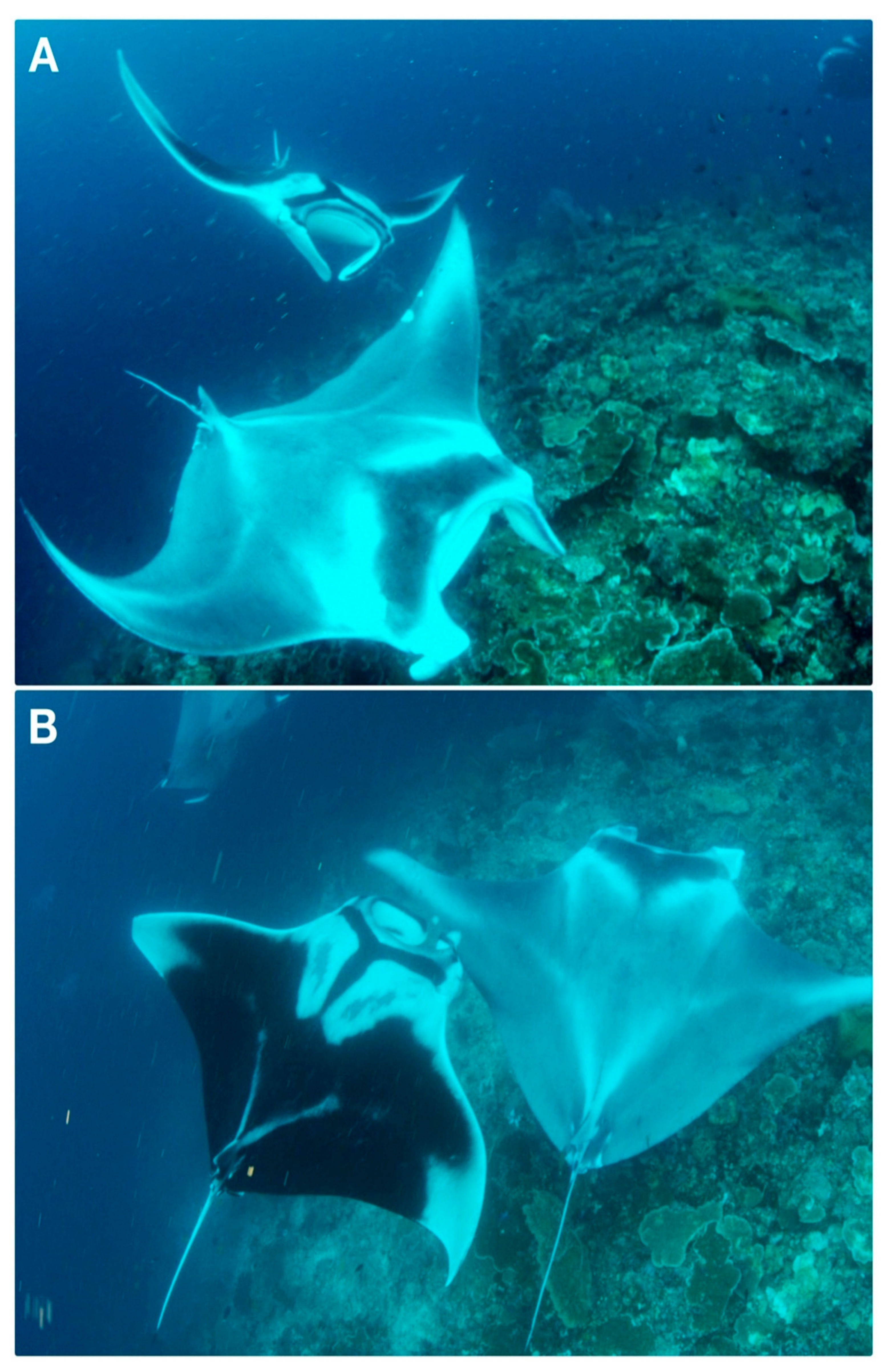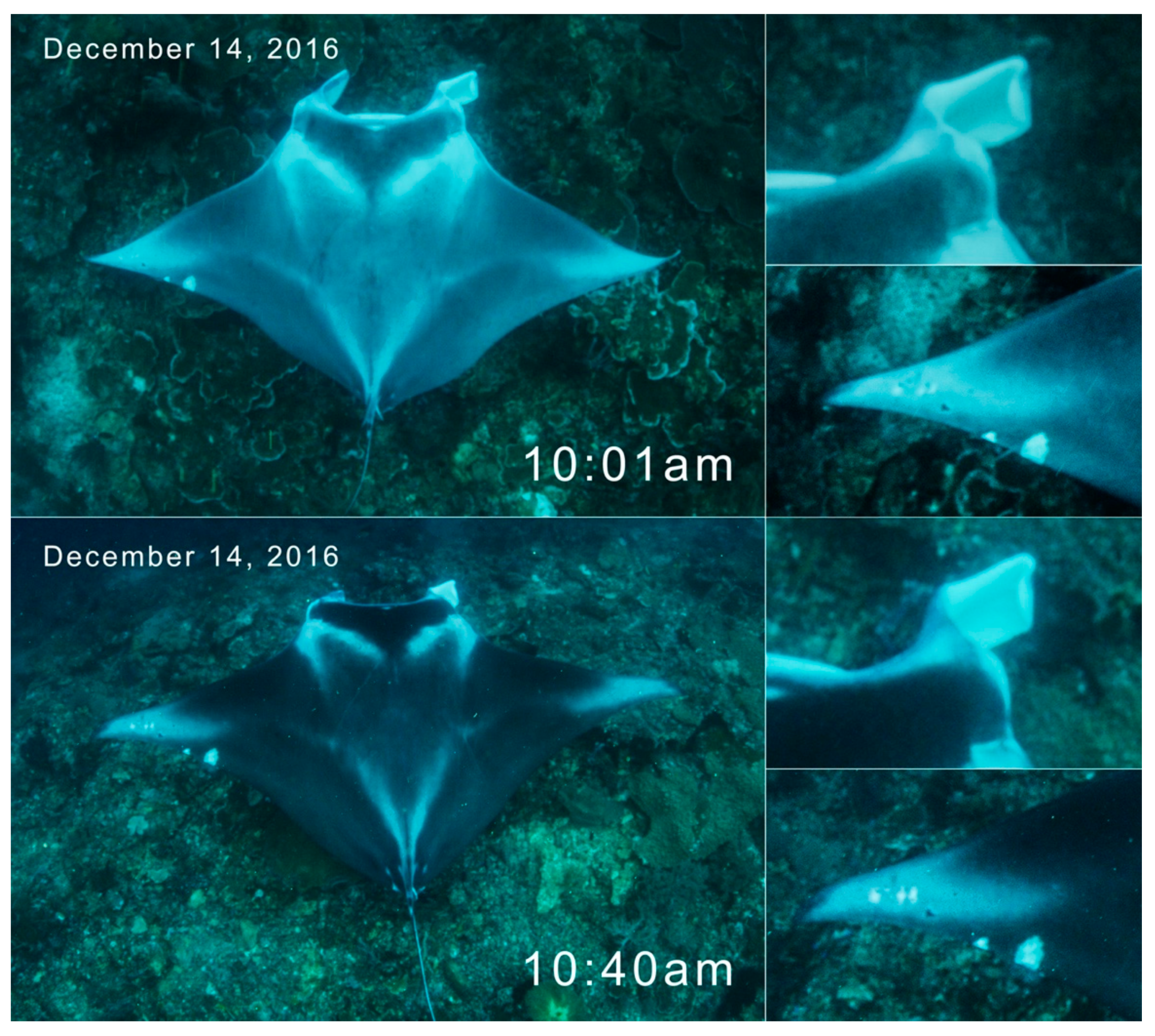First Documented Courtship Behavior between Mobula birostris and M. alfredi at a Coral Reef Cleaning Station in Misool, Raja Ampat
Abstract
Supplementary Materials
Author Contributions
Funding
Institutional Review Board Statement
Data Availability Statement
Acknowledgments
Conflicts of Interest
References
- Marshall, A.D.; Compagno, L.J.; Bennett, M.B. Redescription of the genus Manta with resurrection of Manta alfredi (Krefft, 1868) (Chondrichthyes; Myliobatoidei; Mobulidae). Zootaxa 2009, 2301, 1–28. [Google Scholar] [CrossRef]
- Kashiwagi, T.; Marshall, A.D.; Bennett, M.B.; Ovenden, J.R. The genetic signature of recent speciation in manta rays (Manta alfredi and M. birostris). Mol. Phylogenet. Evol. 2012, 64, 212–218. [Google Scholar] [CrossRef] [PubMed]
- Kashiwagi, T.; Marshall, A.D.; Bennett, M.B.; Ovenden, J.R. Habitat segregation and mosaic sympatry of the two species of manta ray in the Indian and Pacific Oceans: Manta alfredi and M. birostris. Mar. Biodivers. Rec. 2011, 4, e53. [Google Scholar] [CrossRef]
- Setyawan, E.; Erdmann, M.V.; Lewis, S.A.; Mambrasar, R.; Hasan, A.W.; Templeton, S.; Beale, C.S.; Sianipar, A.B.; Shidqi, R.; Heuschkel, H.; et al. Natural history of manta rays in the Bird’s Head Seascape, Indonesia, with an analysis of the demography and spatial ecology of Mobula alfredi (Elasmobranchii: Mobulidae). J. Ocean Sci. Found. 2020, 36, 49–83. [Google Scholar] [CrossRef]
- Walter, R.P.; Kessel, S.T.; Alhasan, N.A.; Fisk, A.T.; Heath, D.; Chekchak, T.; Klaus, R.; Younis, M.; Hill, G.; Jones, B.; et al. First record of living Manta alfredi × Manta birostris hybrid. Mar. Biodivers. 2013, 44, 1–2. [Google Scholar] [CrossRef]
- Beale, C.S.; Stewart, J.D.; Setyawan, E.; Sianipar, A.B.; Erdmann, M.V. Population dynamics of oceanic manta rays (Mobula birostris) in the Raja Ampat Archipelago, West Papua, Indonesia, and the impacts of the El Niño–Southern Oscillation on their movement ecology. Divers. Distrib. 2019, 25, 1472–1487. [Google Scholar] [CrossRef]
- Deakos, M.H. Ecology and Social Behavior of a Resident Manta Ray (Manta alfredi) Population off MAUI, Hawai’i. Ph.D. Thesis, University of Hawai’i at Manoa, Honolulu, HI, USA, 2010. [Google Scholar]
- Germanov, E.S.; Bejder, L.; Chabanne, D.B.; Dharmadi, D.; Hendrawan, I.G.; Marshall, A.D.; Pierce, S.J.; van Keulen, M.; Loneragan, N.R. Contrasting habitat use and population dynamics of reef manta rays within the Nusa Penida marine protected area, Indonesia. Front. Mar. Sci. 2019, 6, 215. [Google Scholar] [CrossRef]
- Marshall, A.D.; Bennett, M.B. Reproductive ecology of the reef manta ray Manta alfredi in southern Mozambique. J. Fish Biol. 2010, 77, 169–190. [Google Scholar] [CrossRef] [PubMed]
- Peel, L.R. Movement Patterns and Feeding Ecology of the Reef Manta Ray (Mobula alfredi) in Seychelles. Ph.D. Thesis, University of Western Australia, Perth, Australia, 2019. [Google Scholar]
- Stevens, G.M.W.; Hawkins, J.P.; Roberts, C.M. Courtship and mating behaviour of manta rays Mobula alfredi and M. birostris in the Maldives. J. Fish Biol. 2018, 93, 344–359. [Google Scholar] [CrossRef] [PubMed]
- Yano, K.; Sato, F.; Takahashi, T. Observations of mating behavior of the manta ray, Manta birostris, at the Ogasawara Islands, Japan. Ichthyol. Res. 1999, 46, 289–296. [Google Scholar] [CrossRef]
- Murakumo, K.; Matsumoto, R.; Tomita, T.; Matsumoto, Y.; Ueda, K. The power of ultrasound: Observation of nearly the entire gestation and embryonic developmental process of captive reef manta rays (Mobula alfredi). Fish. Bull. 2020, 118, 1–8. [Google Scholar] [CrossRef]
- Setyawan, E.; Erdmann, M.V.; Gunadharma, N.; Gunawan, T.; Hasan, A.W.; Izuan, M.; Kasmidi, M.; Lamatenggo, Y.; Lewis, S.A.; Maulana, N.; et al. A holistic approach to manta ray conservation in the Papuan Bird’s Head Seascape: Resounding success, ongoing challenges. Mar. Policy 2022, 137, 104953. [Google Scholar] [CrossRef]
- Setyawan, E.; Stevenson, B.C.; Erdmann, M.V.; Hasan, A.W.; Sianipar, A.B.; Mofu, I.; Putra, M.I.H.; Izuan, M.; Ambafen, O.; Fewster, R.M.; et al. Population estimates of photo-identified individuals using a modified POPAN model reveal that Raja Ampat’s reef manta rays are thriving. Front. Mar. Sci. 2022, 9, 1014791. [Google Scholar] [CrossRef]
- Stevens, G.M.W. Conservation and Population Ecology of Manta Rays in the Maldives. Ph.D. Thesis, University of York, York, UK, 2016. [Google Scholar]
- Setyawan, E.; Stevenson, B.C.; Izuan, M.; Constantine, R.; Erdmann, M.V. How big is that manta ray? A novel and non-invasive method for measuring reef manta rays using small drones. Drones 2022, 6, 63. [Google Scholar] [CrossRef]
- Ari, C. Rapid coloration changes of manta rays (Mobulidae). Biol. J. Linn. Soc. 2014, 113, 180–193. [Google Scholar] [CrossRef]


Disclaimer/Publisher’s Note: The statements, opinions and data contained in all publications are solely those of the individual author(s) and contributor(s) and not of MDPI and/or the editor(s). MDPI and/or the editor(s) disclaim responsibility for any injury to people or property resulting from any ideas, methods, instructions or products referred to in the content. |
© 2024 by the authors. Licensee MDPI, Basel, Switzerland. This article is an open access article distributed under the terms and conditions of the Creative Commons Attribution (CC BY) license (https://creativecommons.org/licenses/by/4.0/).
Share and Cite
Setyawan, E.; Heinrichs, S.; Erdmann, M. First Documented Courtship Behavior between Mobula birostris and M. alfredi at a Coral Reef Cleaning Station in Misool, Raja Ampat. Diversity 2024, 16, 319. https://doi.org/10.3390/d16060319
Setyawan E, Heinrichs S, Erdmann M. First Documented Courtship Behavior between Mobula birostris and M. alfredi at a Coral Reef Cleaning Station in Misool, Raja Ampat. Diversity. 2024; 16(6):319. https://doi.org/10.3390/d16060319
Chicago/Turabian StyleSetyawan, Edy, Shawn Heinrichs, and Mark Erdmann. 2024. "First Documented Courtship Behavior between Mobula birostris and M. alfredi at a Coral Reef Cleaning Station in Misool, Raja Ampat" Diversity 16, no. 6: 319. https://doi.org/10.3390/d16060319
APA StyleSetyawan, E., Heinrichs, S., & Erdmann, M. (2024). First Documented Courtship Behavior between Mobula birostris and M. alfredi at a Coral Reef Cleaning Station in Misool, Raja Ampat. Diversity, 16(6), 319. https://doi.org/10.3390/d16060319






